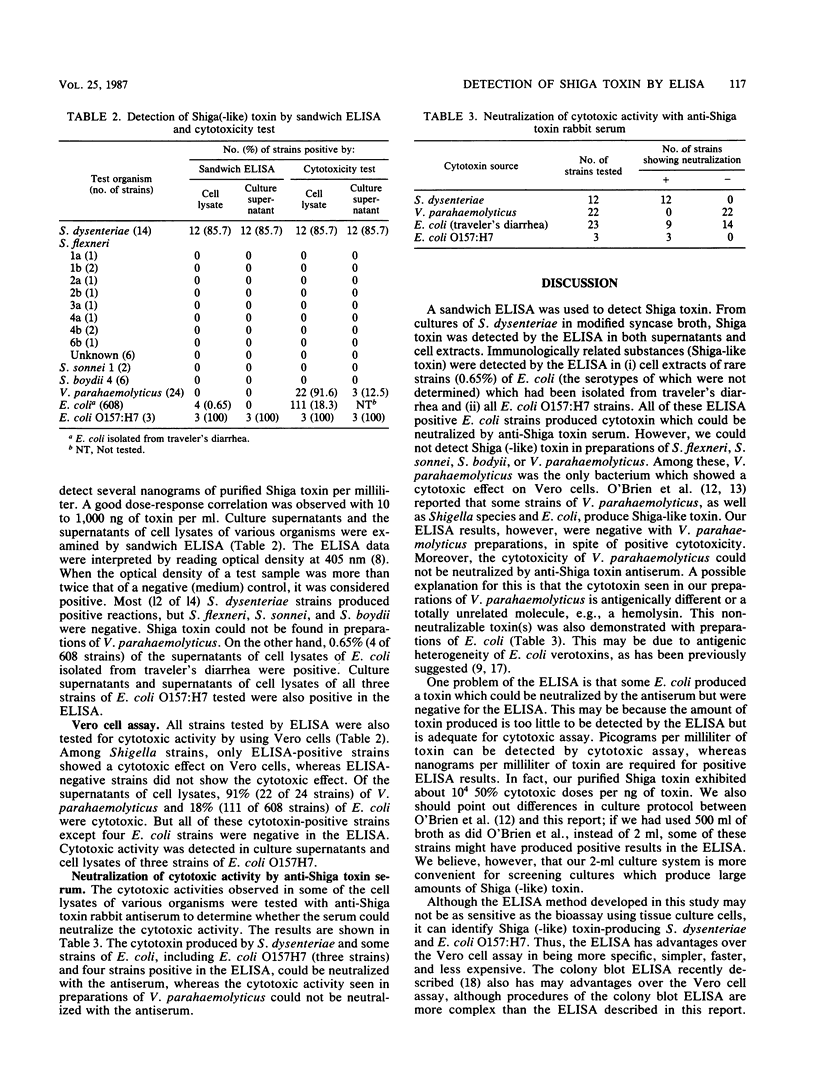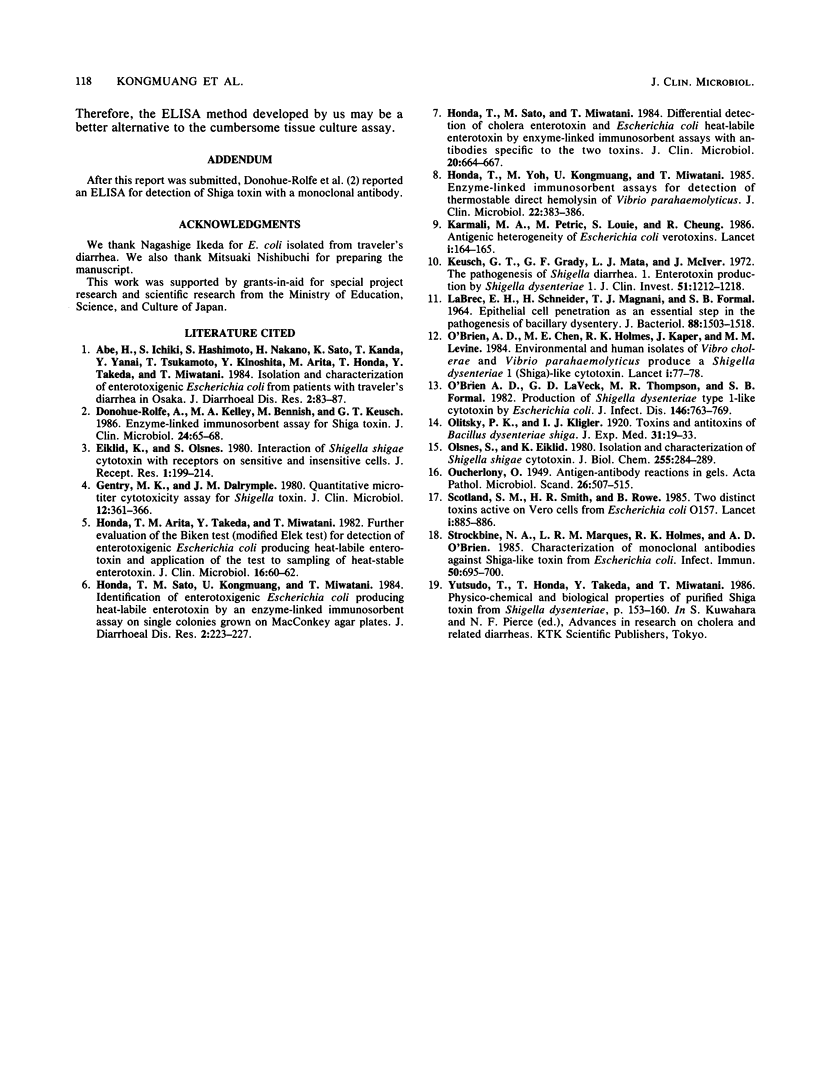Abstract
A sandwich enzyme-linked immunosorbent assay (ELISA) was developed for detection of Shiga toxin. Four species of Shigella, Escherichia coli, and Vibro parahaemolyticus were tested for production of Shiga or Shiga-like toxin by ELISA and Vero cell bioassay. In the ELISA, most strains of S. dysenteriae and some strains of E. coli isolated from traveler's diarrhea were positive. These ELISA-positive strains were positive by Vero cell bioassay without exception. Some E. coli strains and most V. parahaemolyticus strains were toxic to Vero cells, although they were negative in the ELISA. Much of the cytotoxic activity was not neutralized by anti-Shiga toxin antiserum. The newly developed sandwich ELISA is specific and can be a substitute for the cumbersome Vero cell bioassay.
Full text
PDF



Selected References
These references are in PubMed. This may not be the complete list of references from this article.
- Abe H., Ichiki S., Hashimoto S., Nakano H., Sato K., Kanda T., Yanai Y., Tsukamoto T., Kinoshita Y., Arita M. Isolation and characterization of enterotoxigenic Escherichia coli from patients with traveller's diarrhoea in Osaka. J Diarrhoeal Dis Res. 1984 Jun;2(2):83–87. [PubMed] [Google Scholar]
- Donohue-Rolfe A., Kelley M. A., Bennish M., Keusch G. T. Enzyme-linked immunosorbent assay for shigella toxin. J Clin Microbiol. 1986 Jul;24(1):65–68. doi: 10.1128/jcm.24.1.65-68.1986. [DOI] [PMC free article] [PubMed] [Google Scholar]
- Eiklid K., Olsnes S. Interaction of Shigella shigae cytotoxin with receptors on sensitive and insensitive cells. J Recept Res. 1980;1(2):199–213. doi: 10.3109/10799898009044098. [DOI] [PubMed] [Google Scholar]
- Gentry M. K., Dalrymple J. M. Quantitative microtiter cytotoxicity assay for Shigella toxin. J Clin Microbiol. 1980 Sep;12(3):361–366. doi: 10.1128/jcm.12.3.361-366.1980. [DOI] [PMC free article] [PubMed] [Google Scholar]
- Honda T., Sato M., Kongmuang U., Miwatani T. Identification of enterotoxigenic Escherichia coli-producing heat-labile enterotoxin by an enzyme-linked immunosorbent assay on single colonies grown on MacConkey agar plates. J Diarrhoeal Dis Res. 1984 Dec;2(4):223–227. [PubMed] [Google Scholar]
- Honda T., Sato M., Miwatani T. Differential detection of cholera enterotoxin and Escherichia coli heat-labile enterotoxin by enzyme-linked immunosorbent assays with antibodies specific to the two toxins. J Clin Microbiol. 1984 Oct;20(4):664–667. doi: 10.1128/jcm.20.4.664-667.1984. [DOI] [PMC free article] [PubMed] [Google Scholar]
- Honda T., Yoh M., Kongmuang U., Miwatani T. Enzyme-linked immunosorbent assays for detection of thermostable direct hemolysin of Vibrio parahaemolyticus. J Clin Microbiol. 1985 Sep;22(3):383–386. doi: 10.1128/jcm.22.3.383-386.1985. [DOI] [PMC free article] [PubMed] [Google Scholar]
- Karmali M. A., Petric M., Louie S., Cheung R. Antigenic heterogeneity of Escherichia coli verotoxins. Lancet. 1986 Jan 18;1(8473):164–165. doi: 10.1016/s0140-6736(86)92307-x. [DOI] [PubMed] [Google Scholar]
- Keusch G. T., Grady G. F., Mata L. J., McIver J. The pathogenesis of Shigella diarrhea. I. Enterotoxin production by Shigella dysenteriae I. J Clin Invest. 1972 May;51(5):1212–1218. doi: 10.1172/JCI106915. [DOI] [PMC free article] [PubMed] [Google Scholar]
- Labrec E. H., Schneider H., Magnani T. J., Formal S. B. EPITHELIAL CELL PENETRATION AS AN ESSENTIAL STEP IN THE PATHOGENESIS OF BACILLARY DYSENTERY. J Bacteriol. 1964 Nov;88(5):1503–1518. doi: 10.1128/jb.88.5.1503-1518.1964. [DOI] [PMC free article] [PubMed] [Google Scholar]
- O'Brien A. D., Chen M. E., Holmes R. K., Kaper J., Levine M. M. Environmental and human isolates of Vibrio cholerae and Vibrio parahaemolyticus produce a Shigella dysenteriae 1 (Shiga)-like cytotoxin. Lancet. 1984 Jan 14;1(8368):77–78. doi: 10.1016/s0140-6736(84)90006-0. [DOI] [PubMed] [Google Scholar]
- O'Brien A. D., LaVeck G. D., Thompson M. R., Formal S. B. Production of Shigella dysenteriae type 1-like cytotoxin by Escherichia coli. J Infect Dis. 1982 Dec;146(6):763–769. doi: 10.1093/infdis/146.6.763. [DOI] [PubMed] [Google Scholar]
- Olsnes S., Eiklid K. Isolation and characterization of Shigella shigae cytotoxin. J Biol Chem. 1980 Jan 10;255(1):284–289. [PubMed] [Google Scholar]
- Scotland S. M., Smith H. R., Rowe B. Two distinct toxins active on Vero cells from Escherichia coli O157. Lancet. 1985 Oct 19;2(8460):885–886. doi: 10.1016/s0140-6736(85)90146-1. [DOI] [PubMed] [Google Scholar]
- Strockbine N. A., Marques L. R., Holmes R. K., O'Brien A. D. Characterization of monoclonal antibodies against Shiga-like toxin from Escherichia coli. Infect Immun. 1985 Dec;50(3):695–700. doi: 10.1128/iai.50.3.695-700.1985. [DOI] [PMC free article] [PubMed] [Google Scholar]


